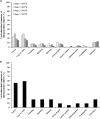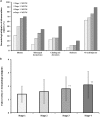The Impact of Gastrointestinal Symptoms and Dermatological Injuries on Nutritional Intake and Hydration Status During Ultramarathon Events
- PMID: 26767151
- PMCID: PMC4701764
- DOI: 10.1186/s40798-015-0041-9
The Impact of Gastrointestinal Symptoms and Dermatological Injuries on Nutritional Intake and Hydration Status During Ultramarathon Events
Abstract
Background: Debilitating gastrointestinal symptoms (GIS) and dermatological injuries (DI) are common during and after endurance events and have been linked to performance decrements, event withdrawal, and issues requiring medical attention. The study aimed to determine whether GIS and DI affect food and fluid intake, and nutritional and hydration status, of ultramarathon runners during multi-stage (MSUM) and 24-h continuous (24 h) ultramarathons.
Methods: Ad libitum food and fluid intakes of ultramarathon runners (MSUM n = 54; 24 h n = 22) were recorded throughout both events and analysed by dietary analysis software. Body mass and urinary ketones were determined, and blood samples were taken, before and immediately after running. A medical log was used to monitor symptoms and injuries throughout both events.
Results: GIS were reported by 85 and 73 % of ultramarathon runners throughout MSUM and 24 h, respectively. GIS during MSUM were associated with reduced total daily, during, and post-stage energy and macronutrient intakes (p < 0.05), whereas GIS during 24 h did not alter nutritional variables. Throughout the MSUM 89 % of ultramarathon runners reported DI. DI during MSUM were associated with reduced carbohydrate (p < 0.05) intake during running and protein intake post-stage (p < 0.05). DI during 24 h were low; thus, comparative analyses were not possible. Daily, during running, and post-stage energy, macronutrient and water intake variables were observed to be lower with severity of GIS and DI (p < 0.05) throughout the MSUM only.
Conclusions: GIS during the MSUM, but not the 24 h, compromised nutritional intake. DI presence and severity also compromised nutrient intake during running and recovery in the MSUM.
Figures




References
-
- Costa RJS, Swancott A, Gill SK, Hankey J, Scheer V, Murray A, et al. Compromised energy and nutritional intake of ultra-endurance runners during a multi-stage ultra-marathon conducted in a hot ambient environment. Int J Sports Sci. 2013;3:51–61. - PubMed
LinkOut - more resources
Full Text Sources
Other Literature Sources

